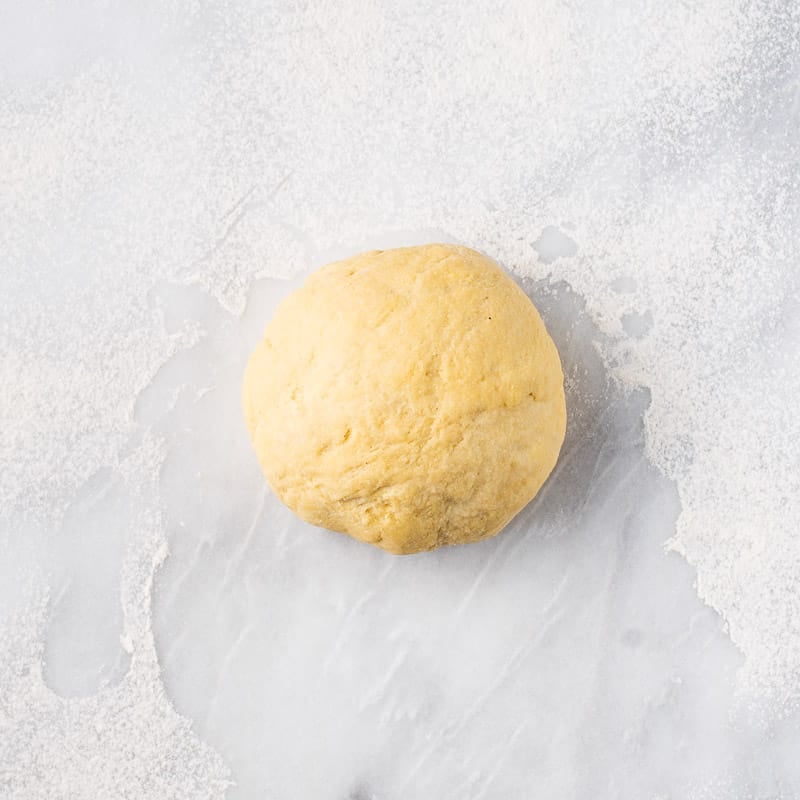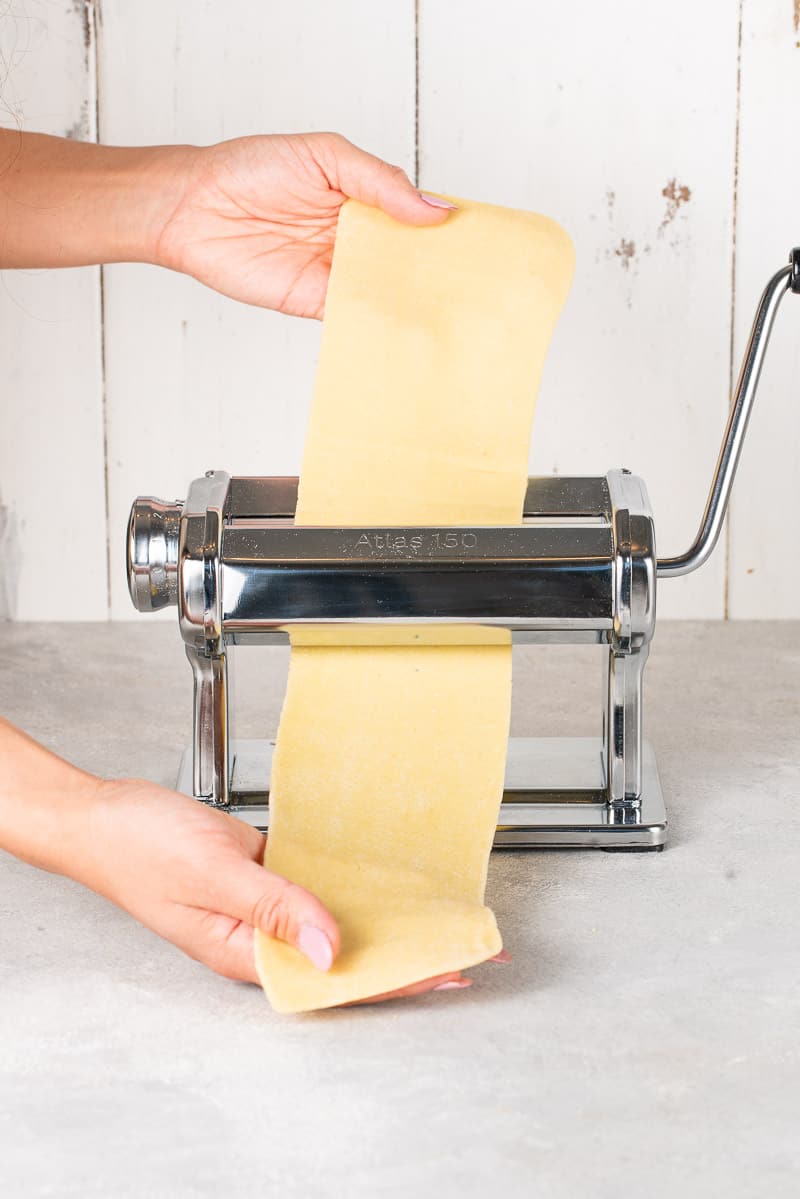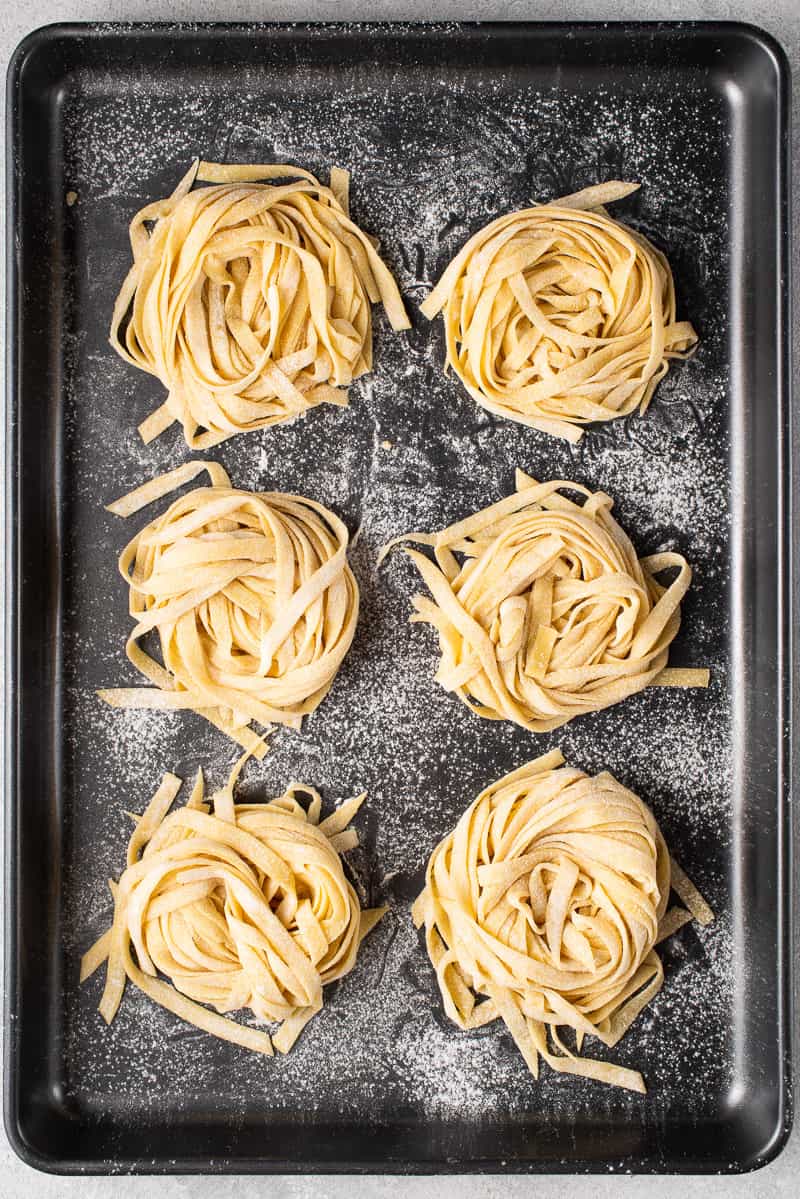This post may contain affiliate links. Please read our disclosure policy.
Making homemade vegan pasta is easier than you think! With just a few simple ingredients and less than an hour, you can enjoy diving into a bowl of fresh pasta noodles topped with your favorite pasta sauces. Get the whole family involved for a night of fun and make this easy recipe together!

Pasta was something that I had almost nightly growing up. Linguini, spaghetti, penne, tortellini, you name it, we ate it. Truth be told, we only made fresh Italian pasta together a few times, but it was always so much tastier than store-bought pasta.
Now, you may know that most homemade pasta dough recipes call for eggs. Of course this isn’t vegan, but thankfully swapping eggs with a vegan egg substitute is incredibly easy! We based this recipe off of my mom’s family friend’s pasta recipes and have successfully created a homemade vegan pasta dough recipe that is exactly like authentic pasta you’d enjoy in Italy! So without further ado, let’s get to work.

Ingredients You’ll Need
- 00 Flour: This flour is a super-finely milled Italian flour made specifically for homemade pastas and pizza dough. You may not be able to find it at every conventional grocery store, so if you need to get it online, you can get it here.
- Semolina Flour: This flour is made from durum wheat and is more coarse than other flour. It also has a darker golden color and an earthy aroma. It’s the perfect flour to use when making homemade pasta. We like to use Bob’s Red Mill semolina flour.
- Vegan Eggs: Most homemade pasta is made with eggs. In order to make this pasta vegan friendly, we opted for Just Egg. It’s a liquid vegan egg substitute made from mung beans and works well as the perfect egg substitute – you won’t even be able to tell the difference. If you can’t find Just Egg or prefer not to use it, replace it with water and salt (full measurements in recipe card below).
Equipment Needed
- Pasta Machine (optional but really helpful!) or rolling pin
- Large mixing bowl
- Fork
- Large pot (for boiling)
- Plastic wrap
- Sharp knife (if cutting by hand)
How to Make Homemade Vegan Pasta Dough









- Bring the Just Egg to room temperature. About 30 minutes before starting this recipe, set the Just Egg or similar egg substitute on the kitchen counter to allow it to warm to room temperature.
- Whisk the dry flours together. In a large bowl, combine the 00 flour and semolina flour until well combined.
- Pour in the Just Egg. Form a well in the center of the combined flours and pour in the liquid vegan egg.
- Mix to combine. Using a fork, mix the Just Egg into the flour until you can’t mix anymore. The mixture will be pretty chunky and dry.
- Add in the water. Using clean hands, mix in the water, a tablespoon or two at a time, until a smooth dough forms. If the eggless pasta dough is sticky, add additional flour. If the dough is dry, add additional water.
- Knead the dough for 5-8 minutes. Turn the fresh vegan pasta dough out onto a clean, floured work surface. Knead the dough until soft and pliable. You’ll know it’s ready when the dough springs back when you poke it with your finger.
- Rest the dough. Once ready, form the pasta dough into a ball and wrap it tightly in plastic wrap. Allow the dough to rest at room temperature for 15 minutes.
How to Roll Out Vegan Pasta Dough with a Pasta Machine
- Prep your work surface. Once you roll out the pasta with the pasta machine, you will rest the pasta as you continue to work. We recommend flouring a clean work surface or lightly dusting a few lint-free linen kitchen towels for this purpose.
- Add the pasta through the pasta machine. Set your pasta machine selector to “0” and feed a lump of dough through the rollers. Repeat this process twice, then fold the ends of the pasta inward to meet allowing the pasta to become a rectangular shape.
- Feed the pasta sheet through 3 more times. Once the pasta is in a rectangular shape with sharp edges, feed it through the machine three more times to get it as thin as possible. If it begins to stick at all, dust the dough with additional flour.
- Increase the thickness setting until your desired thickness is reached. In most standard pasta machines, setting 0 or 1 is the thinnest setting and 9 or 10 is the thickest. You will need to adjust the thickness of your pasta depending on the recipe. For example, when we make our Herbed Ricotta Ravioli, we like to use setting 7 and when we make fettuccine, we like to use setting 5. Start with running the pasta through on setting 1, then setting 2, and continuing until your desired consistency is reached.
- Add the cutting rollers. Lightly dust the dough once more, then add the cutting rollers onto the pasta machine and feed the pasta through once more.
- Set the pasta aside to dry out. Set the dough aside on a floured area and allow it to dry out slightly (for about 30 minutes).
How to Roll Out Vegan Pasta Dough by Hand
- Roll the dough into one long piece. After the homemade vegan dough has rested for 15 minutes at room temperature, add additional flour to your clean work surface and roll the dough out into one long piece.
- Fold each end inward. Take both ends of the long piece of dough and fold them inwards to meet each other.
- Roll out the dough again. Roll the dough into a large rectangle that is so thin you can see your hands through it.
- Cut the pasta. Lightly sprinkle the pasta dough with flour, then cut the dough into your ideal shape.
- Set the pasta aside to dry out. Once the pasta is cut into your desired shape, let the pasta sit out for about 30 minutes until slightly dried out.
Cooking Homemade Pasta
- Boil a large pot of water. Bring a generously salted pot of water to a rolling boil. Add in the fresh pasta and cook for 2-4 minutes, depending on thickness.
- Drain the pasta. Once the pasta is al dente, drain the pasta using a colander, reserving up to 1 cup of pasta water to combine with your pasta sauce of choice.
- Serve as desired. Serve this delicious homemade vegan pasta with your favorite creamy sauce, fresh veggies, or as desired.

Serving Suggestions
Enjoy this homemade vegan pasta with your favorite pasta sauce and simple sides such as this Easy Vegan Garlic Bread or these Garlic Herb Dinner Rolls. Here are a few of our favorite homemade vegan spaghetti sauce recipes:
- Roasted Red Pepper Pasta Sauce
- Vegan Lentil Bolognese Sauce
- Roasted Butternut Squash and Tomato sauce
- Easy Homemade Marinara Sauce
- Classic Vegan Pesto
You can also use this homemade vegan pasta to make this Herbed Ricotta Ravioli, this Butternut Squash Ravioli, or the Best Vegan Lasagna. This pasta dough is a great base recipe, so don’t be afraid to get creative! If you have a KitchenAid Stand Mixer, consider investing in the pasta attachment to make different shapes like bucatini, rigatoni, fusilli, large macaroni, or small macaroni simply by changing the pasta disc.
Storage Instructions
Make ahead: Fresh homemade vegan pasta dough can be prepped ahead and frozen until ready to use. To do so, follow the recipe through recipe step 8. Form the dough into a ball, lightly flatten it into a disc, then tightly wrap it in a few layers of plastic wrap and refrigerate for up to 2 days or freeze for up to 1 month.
How to store cooked pasta: Once cooked, homemade vegan pasta will keep in the refrigerator in an airtight container for up to 3 days. For best results, store the pasta coated in sauce or a light drizzle of oil to prevent sticking.
Tips & Tricks for Success
- Add the water slowly. When making the homemade vegan pasta dough, we recommend adding lukewarm little by little until your dough is soft and pliable. The amount of water needed may vary day-to-day and climate-to-climate. If you add too much water, you can balance it out with more flour until the dough feels right.
- Don’t skip the rest periods. Allowing the kneaded pasta dough to rest for 15 minutes helps hydrate and relax the dough. This will make it considerably easier to roll out and make the pasta tender and delicious.
- Flour is your friend. To prevent the pasta sheets from sticking together or to the work surface, keep them lightly floured at all times. For added protection, we recommend keeping all of your surfaces floured as well.
- Invest in a pasta machine. In order to achieve super-thin pasta, a pasta maker definitely comes in handy. We have this one, but there are many other options to choose from, if desired.
Pasta Dishes to Try with this Homemade Vegan Pasta:
- Easy Garlic and Herb Pasta – made with a simple combination of extra virgin olive oil, garlic, fresh herbs, and vegan parmesan cheese.
- Classic Vegan Macaroni Salad – one of our favorite pasta recipes to dive into in the hot days of summer.
- Easy Roasted Vegetable Pasta – a quick and easy lunch or dinner packed with cherry tomatoes and your favorite veggies.
- Vegan Broccoli Rabe & Sausage Pasta – a delicious protein-packed pasta loaded with unique flavors.
- Vegan Sun-Dried Tomato Pesto Pasta – the perfect recipe to use up tons of fresh basil and nutritional yeast.

Authentic Homemade Vegan Pasta Recipe
- Total Time: 43 minutes
- Diet: Vegan
Description
Making homemade vegan pasta is easier than you think! With just a few simple ingredients and less than an hour, you can enjoy diving into a bowl of fresh pasta noodles topped with your favorite pasta sauces. Get the whole family involved for a night of fun and make this easy recipe together!
Ingredients
- 250 grams 00 flour
- 250 grams semolina flour
- 3/4 cup room temperature just egg
- About 100ml warm water or 1/3 cup, as needed
Equipment
- Large bowl
- Fork
- Clean work surface
- Pasta machine or rolling pin
- Large pot (for boiling)
- Plastic wrap
- Sharp knife (if cutting by hand)
Instructions
- Remove the just egg from the refrigerator about 30 minutes before starting this recipe to allow it to come to room temperature (or just about).
- In a large bowl, add in the flours. Whisk together until uniform.
- Form a small well in the middle of the flour mixture and pour in the Just Egg.
- Using a fork, mix the just egg into the flour until you can mix anymore. It should be chunky dough as pictured in the blog post.
- Using clean hands, mix in the water, a tablespoon or two at a time, until a smooth dough forms. The dough should not be sticky nor should it be dry and crumbly. The amount added may vary based on your location or your flour, but we added around 100 ml. If the dough is too dry, add some water, if it is too sticky add some flour.
- Flour a clean work surface and turn the dough onto it.
- Flour your hands and knead the dough until soft and pliable, about 5-8 minutes. When you poke the dough, it should spring back.
- Form the dough into a ball with your hands and wrap it tightly in plastic wrap. Let the dough rest at room temperature for 15 minutes.
- Roll out the pasta dough into your desired shape, either by hand or using a pasta maker (see notes above). Cook the pasta in a large pot of generously salted boiling water until it is al dente, usually between 1-5 minutes depending on the thickness of your pasta. Drain and use immediately.
- Unwrap the dough and divide it into 8 equal pieces so that it’s easier to work with. Take 1 piece and wrap the rest back up in the plastic wrap.
- Rolling out by hand: Lightly flour a clean work surface and roll out the dough into one long piece. Fold the top and the bottom of the sough inward to meet each other, and then begin to roll the dough out again, up-down and left-right to form a rectangle. You’ll know the dough is ready when you’re able to see your hands through it. Lightly sprinkle the dough with flour and then cut the dough into your ideal shape. To make it easier, you can lightly fold the dough into itself twice so you don’t have to cut through too much. Set the dough aside onto a floured area of your work surface and continue rolling out all of your dough. Let the pasta sit out for about 30 minutes to dry out slightly.
- Rolling out with the machine: Flour a clean work surface OR flour a few lint-free linen kitchen towels and lay them next to the pasta machine so that the pasta you roll out will rest on it. Lightly dust your piece of dough. Set the machine selector to 0 and feed a lump of dough through the rollers. Repeat this twice, and then fold the ends of the pasta sheet inward to meet, allowing it to become a rectangular shape. Repeat 3 more times, dusting the dough with more flour if it begins to stick. Increase the thickness setting to 1 and feed the pasta through once, continue this until you have reached your desired thickness setting. This will depend on the type of pasta you make. For the fettuccine pictures, we rolled it out to a 5. For ravioli, we roll it out to an 7. Lightly dust the dough once more. Add the cutting rollers onto the machine and feed the pasta through them. Set the dough aside onto a floured area of your work surface and continue rolling out all of your dough. Let the pasta sit out for about 30 minutes to dry out slightly.
- Bring a large pot of generously salted water to a boil. Once boiling, add in the fresh pasta. Cool for 2 to 4 minutes, depending on its thickness.
- Drain the pasta, reserving about 1/2 to 1 cup of the water, and add the cooked pasta back to the pot along with your sauce of choice. Stir to coat, adding some of the reserved pasta water if needed to add body to the sauce, and dig in!
Notes
- If you would like to prep this dough in advance, after kneading then dough, wrap it in plastic wrap and place it into the refrigerator. Remove it from the refrigerator and allow it to come to room temperature before using.
- We have made this recipe without the liquid vegan egg before with success. You will just need to salt the dough as it will lack in flavor. We prefer the vegan egg version but if you don’t have access to it, this works well in its place.
- 250 g each flour
- About 1 1/3 cup Water
- 3/4 to 1 teaspoon of salt, or as needed
- Prep Time: 40 minutes
- Cook Time: 3 minutes
- Category: Entree
- Cuisine: Italian
Make sure you tag us on Instagram @sweetsimplevegan and @consciouschris and hashtag #sweetsimplevegan if you recreate any of our recipes, we love to see your photos!













Turned out amazing. My husband said it’s definitely the best pasta I’ve ever made and maybe the best pasta he’s ever had
I love the texture – chewy and perfect! I made a vegan carbonara with this recipe.
Great pasta! I tried my hand at it with my Kitchen Aid pasta rollers and it was amazing. The recipe was very easy, and it was fun making the pasta. It has a really nice texture and flavor, and paired well with a homemade alfredo. Definitely making this again.
Perfect pasta!
Amazing egg noodles! I used these to recreate holiday “chicken” and noodles, and they turned out amazing. The recipe is simple as a first time pasta maker, and the dough was easy to work with.
The only note I have is that step 9 is unnecessary. It seems like the end of the recipe, then it jumps back in at 10. Maybe the steps are out of order or it was duplicated and is no longer needed?
This was great!
One question, when you dry the pasta do you put them in nests like the picture? I did this because of the picture and it wasn’t specified in the instructions but the noodles ended up sticking together.
Thanks!